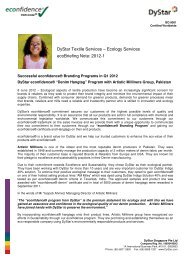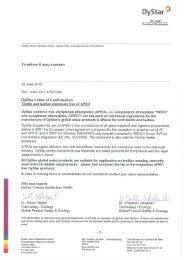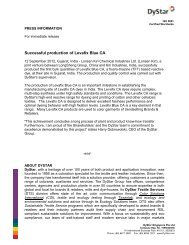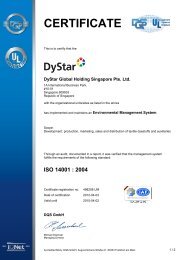Read the DyStar Sustainability Report 2011...
Read the DyStar Sustainability Report 2011...
Read the DyStar Sustainability Report 2011...
Create successful ePaper yourself
Turn your PDF publications into a flip-book with our unique Google optimized e-Paper software.
Occupational Health and Safety<br />
Workplace safety is a core value at <strong>DyStar</strong>. The production of dyes involves<br />
handling a variety of chemicals, including hazardous substances with<br />
potential health and safety hazards. Employee safety <strong>the</strong>refore is a top<br />
priority for us.<br />
Potential health and safety risks in a chemical plant may emerge from<br />
handling of hazardous materials, hazards of pressure vessels, hazardous<br />
chemical reactions, flammable gases, vapours and dust hazards. O<strong>the</strong>r<br />
potential hazards include heat stress, accidental escapes or spills of<br />
hazardous material, hazards due to corrosion, work in confined spaces,<br />
slips, trips and falls, working with pipelines, plant repair, instrument<br />
failures, exposure to harmful substances and disposal of waste.<br />
Common injuries include chemical burns, skin irritation, respiratory<br />
irritation, back ache and o<strong>the</strong>r musculoskeletal injuries, eye injury and<br />
slip, trip and fall.<br />
We have integrated <strong>the</strong> Responsible Care program into our occupational<br />
health and safety policies. This includes a commitment to protecting<br />
company employees from direct and long-term health risks by identifying<br />
health hazards and providing information, training and suitable protection.<br />
Occupational health and safety policies that <strong>DyStar</strong> has implemented<br />
cover:<br />
• Operating procedures<br />
• Occupational safety<br />
• Preventive healthcare<br />
• Safe technology<br />
• Hazardous substances<br />
• Production processes<br />
We are continuously improving our approach to plant safety. Technical<br />
standards in plants are adapted in line with technological advancements.<br />
Production and o<strong>the</strong>r equipment is inspected regularly and systematically<br />
for safety. Detailed procedures have been implemented in plants to<br />
deal with incidents and to limit <strong>the</strong>ir impact. Each <strong>DyStar</strong> plant has<br />
developed and implemented a detailed hazard prevention plan. Regular<br />
training is provided to employees to enable <strong>the</strong>m to handle plant and<br />
equipment in a safe manner. A thorough emergency response plan<br />
has been put in place at each plant to effectively handle accidents and<br />
hazardous situations.<br />
Employees participate in safety committees set up at <strong>the</strong> plant level to<br />
regularly review, discuss and take measures for continues improvement in<br />
safety performance. Safety committees meet at least once a month to<br />
review safety matters. Monthly safety inspections are also carried out<br />
at each plant.<br />
We regularly track occupational health and safety performance. In<br />
2011, <strong>the</strong>re were only eight recordable incidents of workplace injuries<br />
across 16 <strong>DyStar</strong> plants worldwide as compared to 13 incidents in<br />
2010. All <strong>the</strong> eight incidents involved male employees. There were no<br />
recordable incidents of injury in 14 plants, an improvement from 2010<br />
when only 10 plants reported no recordable injuries. In total, 34 workdays<br />
were lost on account of workplace injuries as against 490 days in 2010.<br />
One of <strong>the</strong> unfortunate incidents of injury which took place in <strong>the</strong><br />
Pietermaritzburg plant in South Africa in November 2011 was reported<br />
in <strong>the</strong> local media. An employee involved in <strong>the</strong> incident sustained<br />
chemical burns when he was in <strong>the</strong> process of making a new trial<br />
product for a customer. A sudden chemical reaction occurred before<br />
he could secure <strong>the</strong> lid of <strong>the</strong> vessel, this resulted in splashing of chemicals<br />
on his body. He was immediately rushed to hospital to receive treatment.<br />
He has since fully recovered and has resumed work.<br />
The plant management has introduced new measures after a thorough<br />
investigation of <strong>the</strong> incident to prevent recurrence. The plant management<br />
also partnered with <strong>the</strong> customer to provide Hazard & Operability<br />
Analysis (HAZOP) training for <strong>the</strong> manufacturing of new products to<br />
all operators.<br />
There were no incidents involving fatality in 2011 as was <strong>the</strong> case in<br />
2011 <strong>Sustainability</strong> <strong>Report</strong> - <strong>DyStar</strong> Group 33

















